This was published 2 years ago
John Russell had big plans, but he ended up dead at the bottom of a Bondi cliff
John Russell had big plans in 1989. The 31-year-old was living in Bondi with his brother and was excited about building a home on his father’s farm near Cessnock in NSW’s Hunter Region.
On November 23, 1989, his lifeless body was found on the rocks beneath the Bondi to Tamarama coastal walk around Marks Park, a popular gay beat.
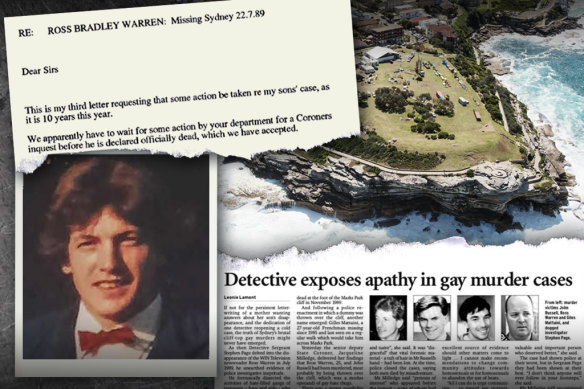
Clockwise from left: John Russell, whose body was found in 1989 around Bondi’s Marks Park; a letter from the mother of Ross Warren, who disappeared in the same area; an aerial view of Marks Park and a newspaper report from 2005.
Russell had human hairs on his left hand. His body – head and shoulders facing towards the cliff, his legs seaward – was in an unusual position for a suicide or misadventure, two forensic pathologists noted in 2001 and 2017.
The missing evidence
There was also the matter of the hairs. The same experts considered it relatively unlikely the strands came from Russell’s own head. Neither ruled out foul play.
But the NSW commission of inquiry into LGBTIQ hate crimes heard the hairs, after being bagged by police for analysis, were lost in about 1989 and were never forensically examined.
The inquiry, headed by Supreme Court Justice John Sackar, is examining dozens of unsolved deaths in NSW between 1970 and 2010. It concluded a fourth tranche of hearings on Monday with more scheduled for later this month.
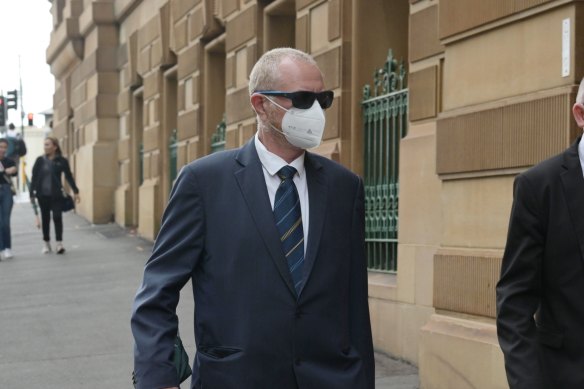
Detective Sergeant Steve Morgan outside the LGBTIQ hate crimes inquiry in February.Credit: Nick Moir
Detective Sergeant Steve Morgan, who was not involved in the original police investigation into Russell’s death but oversaw a reinvestigation from 2016, conceded at the inquiry last month that losing the hairs was a “very significant flaw” in the initial investigation.
He also agreed that it would be unusual to find hairs on the hands of a person who had jumped to their death. But Morgan agreed that, in his view, the most probable cause of Russell’s death was an accidental fall due to intoxication.
“Personally, I do still feel it was misadventure. But I understand it’s very subjective, and I understand if others see it differently,” Morgan said.
A mother’s pleas
Kay Warren penned a plea to NSW Police in July 1998. Her son Ross, a TV newsreader, had been reported missing in July 1989, aged 25. His friends found his car in Bondi near Marks Park, and his keys were located nearby on rocks near the water’s edge.
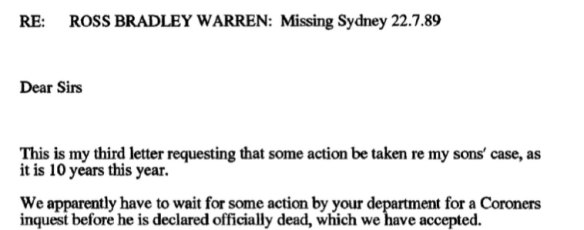
Letter from Kay Warren to NSW Police dated May 26, 1999.
A police officer coordinating the investigation into Warren’s disappearance said within days that police were “of the opinion that the missing person has fallen into the ocean in some manner”. Warren’s suspected death was not reported to the coroner.
“As it is now 9 years since Ross disappeared, we feel it is time for a Coroners’ inquest to close the case,” Kay Warren wrote. She was seeking a death certificate rather than an inquest, the inquiry heard.
She received no reply. In April 2000 she wrote her sixth letter, this time to the NSW police commissioner. “It is eleven years this July since my son disappeared,” it began.
A fresh investigation
It was not until Stephen Page, then a detective sergeant, happened upon Warren’s letters that the investigative wheels started turning once again.
“He sent a report, I think first of all to Paddington [police], to try and get it investigated,” Morgan told the inquiry.
In June 2001, Page would be appointed commander of Operation Taradale, an investigation into the death of Russell, the disappearance and suspected death of Warren, and later the disappearance and suspected death of a third man, French national Gilles Mattaini, in the same area.
Mattaini – who, like Russell and Warren, was gay – was last seen on the Bondi to Tamarama coastal walk around Marks Park in September 1985. He was 27.
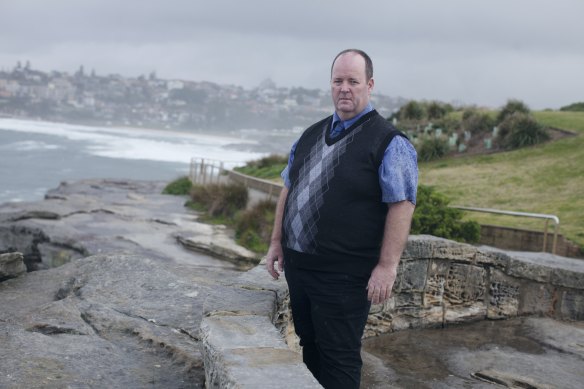
Detective Steve Page, photographed in 2013, led an investigation into the suspected murders at Bondi, Operation Taradale, that would consume years of his life. He has since left the force. Credit: James Brickwood
Two murder findings
The work of Taradale and Page, who left the force in 2004, would be praised by then deputy state coroner Jacqueline Milledge in 2005 as “thorough” and “impeccable”.
Milledge found Russell and Warren died after meeting with foul play. Mattaini had died, she found, and while his manner and cause of death was undetermined, there was a “strong possibility” he died in similar circumstances to Russell and Warren.
Milledge said threats to throw victims off the cliff face “was a modus operandi of some gay hate assailants” around Marks Park at the time of the men’s disappearances and death, and this “strongly supports the probability” all three men died in this way.
A reinvestigation
Despite Milledge’s findings, NSW Police set up the secretive Strike Force Neiwand in 2015 to reinvestigate the three Bondi cases, the inquiry heard. In 2017, Neiwand effectively reversed the coroner’s findings without speaking to dozens of persons of interest.
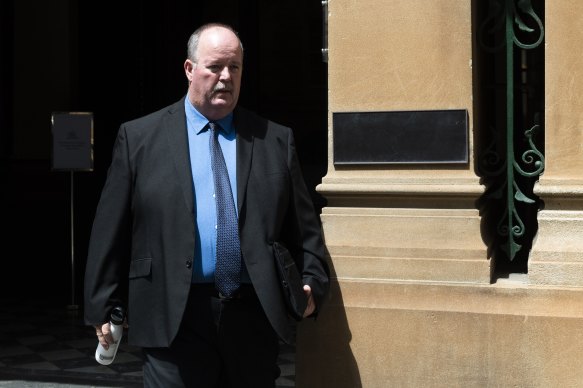
Former police officer Stephen Page outside the LGBTIQ hate crimes inquiry on February 28.Credit: Rhett Wyman
Neiwand had alleged in internal police documents that Taradale was infected by “tunnel vision” and had “relied on investigation confirmation bias which was a major factor that ultimately limited the validity of the coroner’s findings”.
Morgan, the investigation supervisor of Neiwand from 2016, agreed at the inquiry that those allegations were unjustified. He said investigators started with an open mind but agreed the strike force ultimately put more effort into finding evidence that might indicate suicide or misadventure than homicide.
Page, who now works in the private sector, told the inquiry: “I think my reputation was absolutely professionally destroyed in those reports.”
The case with ‘zero solvability’
In 2012, a NSW police officer in the unsolved homicide team conducted a review of another cold case, the 1988 death of US national Scott Johnson. She concluded the “solvability” of the case was zero.
The naked body of Johnson, 27, was found at the base of a cliff near Manly’s North Head on December 10, 1988. A first inquest in 1989 found he died by suicide while a second inquest in 2012 returned an open finding.
Page, who was by this time a former police officer, attended Manly Police Station in March 2006 with Johnson’s brother Steve to seek a reinvestigation of Scott’s 1988 death because of potential parallels with the Bondi cases.
In 2017, then-coroner Michael Barnes concluded after a third inquest that Scott died “as a result of a gay hate attack”. The inquiry heard NSW Police submitted to this inquest that suicide was the most likely cause of death.
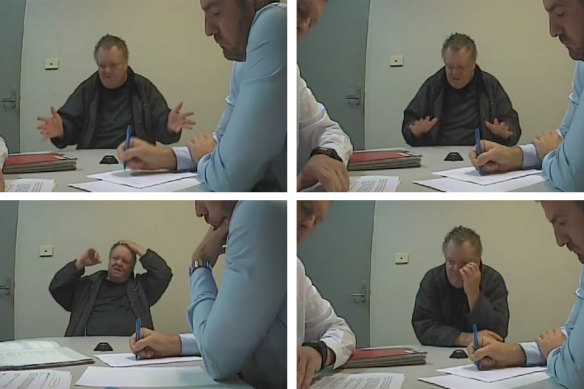
Scott Phillip White being interviewed by police in May 2020.
Sydney man Scott Phillip White was charged in May 2020 with murder over Scott’s death. White pleaded guilty to manslaughter last month and will be sentenced later this year.
A police review
The inquiry has heard evidence that as at 2014 senior NSW police officers believed claims relating to the number of gay hate-related murders and bashings in the 1980s and ’90s were exaggerated and unfounded. Against that backdrop, NSW Police set up Strike Force Parrabell in 2015 to review 88 deaths between 1976 and 2000 that had been reported in the media and elsewhere as potentially involving motivations of gay-hate bias.
Parrabell’s 2018 report found evidence of a bias crime in just eight cases. A further 19 cases were suspected bias crimes. There was insufficient information in 25 cases and no evidence of bias crime was found in 34 cases. Two cases were excluded from the review.
A team at Flinders University was contracted to review the work of the police, and academics had been told in tender documents that they would need to take a “collaborative approach”.
The academic team said in the final report that they were “reluctant to endorse” the bias crime indicators used by police.
Dr Derek Dalton, who was involved in the academic review, told the inquiry that in his experience Parrabell had been a “poisoned chalice”.
“I’m not a police apologist. I’ve spent years of my life documenting hate against gay people.”
The inquiry resumes later this month.
The Morning Edition newsletter is our guide to the day’s most important and interesting stories, analysis and insights. Sign up here.